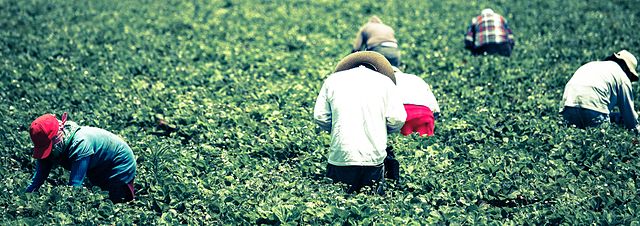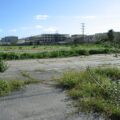Health advocates push for pesticide prevention
By Michael Collins
Ventura County Reporter – November 20, 2003

The Oxnard-based Wishtoyo Foundation is known for resurrecting respect for and knowledge of the Chumash culture that once extended from San Luis Obispo to Malibu. But the group, led by Mati Waiya, has now set its sights on more pressing problems facing native and non-native locals alike—pesticide use in Ventura County.
In a 46-page preliminary report by the foundation’s California Coastal Agritoxin Monitoring Program, the group focuses on the toxic pesticides used to treat Ventura’s agricultural zones, which comprise 44 percent of the county. The report details how some of the most dangerous toxic pesticides are used in Ventura and are linked to a myriad of health problems including birth defects, neurological impairment, infertility and cancer. The use of these pollutants, which impact the air, water and soil, affects farmworkers, children, the elderly and an unsuspecting Ventura public.
“Pesticides can cause both short and long term adverse health effects,” the report states. “Immediate (acute) health effects include blindness, blisters, diarrhea, dizziness, nausea, rashes, stinging eyes and death. Long-term (chronic) adverse health effects can occur months or years after initial exposure. These include birth defects, cancers, and developmental and neurological damage. In addition, pesticides can poison and disrupt immune systems and endocrine systems. A damaged or compromised immune system limits one’s ability to fight infections and diseases. The degradation of the human immune system may indeed be the most significant health effect caused by contact with toxic chemicals in the environment.”
The study points out that irrigation and storm water runoff carry nearly 80 percent of agricultural pesticides into the county’s rivers, estuaries and seashores. Surfers, swimmers and kids are especially defenseless to the hazards of this surfeit.
“I grew up in Saticoy, which means in the Chumash language ‘shielded by the wind,’” says Waiya.
“I wish we were shielded by the wind that carries the poisons. I wish we were all shielded by that. In this little town I grew up in, back in the day, there was agriculture or natural lands all around you. The thing that I see more and more of is the natural products, the seasonal products, have slowly been disappearing. Strawberries and sod are slowly replacing all the produce. It’s not like we’re eating the sod, yet it is exempt from all the laws…. It is using three times more water and poisons than a certain product or vegetable that we would be eating.”
The Wishtoyo report contends that the pesticide industry plays down the toxic threat and that, instead of focusing on agricultural water runoff, the industry places its emphasis on simply labeling and registering pesticides rather than reducing or eliminating these hazardous chemicals. The group points out that the monitoring of these agritoxins is often compromised or is absent despite laws to the contrary. One example is that Ventura County has no air-testing program to gauge these poisons although law requires it.
“This report highlights the public health imperative to reduce pesticide use in California,” says Martha Arguello, director of health and environment programs for the Los Angeles-based chapter of the public health organization Physicians for Social Responsibility. For the last five years, the group has been working with Californians for Pesticide Reform to protect people from the threat of agricultural venoms. “Every day, thousands of farmworkers risk their lives in these poisoned fields so that we can be the ‘salad bowl of the nation.’ Farmworkers and the thousands of families living near agricultural fields are bearing the burden of our addiction to agritoxins. The enormity of this injustice and the public health threat requires thoughtful yet swift action to reduce the use of the most dangerous pesticides and an overall reduction in the use of all pesticides. We can do this with public policies that support the transition to more sustainable agricultural practices.”
“We expose thousands of women of child-bearing age to a mix of developmental and reproductive toxins,” says David Chatfield, executive director of Californians for Pesticide Reform, a coalition of 170 organizations working to reduce overall use of pesticides and phase out the most hazardous. “Many agricultural chemicals haven’t been tested for long-term health impacts. The only realistic way to protect women, children and our water supply from pesticide contamination is to reduce its use.”
But that use of this toxic soup won’t end soon. According to the Wishtoyo report, Ventura County ranked 9th among the 58 counties of California in the employment of agritoxins in 2001, utilizing 3,485 pounds of pesticides per square mile of farmland. Over the past decade, more than six million pounds of agritoxins have been used in the county, an increase of 63 percent since 1989. From 1995 to 2000, the most widely used chemicals were petroleum oil, methyl bromide, chloropicrin, metam-sodium and glyphosate. Though statewide use of methyl bromide has dropped from 1995 to 2000, Ventura’s use incre ased by 59 percent. The chemical will be phased out beginning in 2005 but replacement pesticides are on the increase. The highly toxic insecticide telone has soared in usage from 680 pounds in 1995 to 100,347 pounds in 2001.
Naturally, farmworkers are the most exposed in the county’s $3.6 billion agricultural economy. The 35,000 agricultural employees in the county are of primarily Hispanic descent. Despite the fact that Ventura County mothers have the highest level of prenatal care in the state, the Latino infant mortality rate was more than seven for every 1,000 births in 2001, higher than California’s average.
“One of the concerns is that the children, when they go and hug their parents when they get home from work, the parents have chemicals on their clothing,” says Waiya. “They’re happy to see their mother or their father and little do they know they are being exposed and touching poisons and then going and eating. There are no brochures that can ensure the workers at the workplace of how dangerous this is. They are not educated. They don’t know how really deadly these chemicals are. They are just going home after a hard day’s work.”












Recent Comments